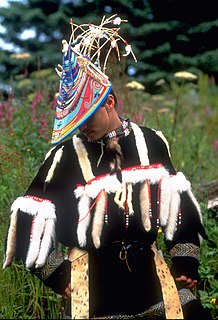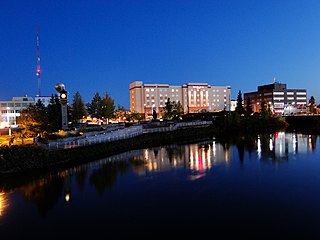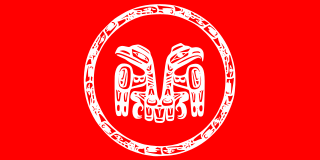
The Iñupiat are native Alaskan people, whose traditional territory spans Norton Sound on the Bering Sea to the Canada–United States border. Their current communities include seven Alaskan villages in the North Slope Borough, affiliated with the Arctic Slope Regional Corporation; eleven villages in Northwest Arctic Borough; and sixteen villages affiliated with the Bering Straits Regional Corporation.

The Alutiiq people, also called by their ancestral name Sugpiaq, as well as Pacific Eskimo or Pacific Yupik, are a southern coastal people of Alaska Natives. They are not to be confused with the Aleuts, who live further to the southwest, including along the Aleutian Islands.

Inupiaq, Inupiat, Inupiatun or Alaskan Inuit, is a group of dialects of the Inuit languages, spoken by the Iñupiat people in northern and northwestern Alaska, and part of the Northwest Territories. The Inupiat language is a member of the Inuit-Yupik-Unangan language family, and is closely related to Inuit languages of Canada and Greenland. There are roughly 2,000 speakers. It is considered a threatened language with most speakers at or above the age of 40. Iñupiaq is an official language of the State of Alaska.

The Eiteljorg Museum of American Indians and Western Art is located in downtown Indianapolis, Indiana and houses an extensive collection of visual arts by indigenous peoples of the Americas, as well as Western American paintings and sculptures collected by businessman and philanthropist Harrison Eiteljorg (1903–1997). The museum houses one of the finest collections of Native contemporary art in the world.

Northwest Coast art is the term commonly applied to a style of art created primarily by artists from Tlingit, Haida, Heiltsuk, Nuxalk, Tsimshian, Kwakwaka'wakw, Nuu-chah-nulth and other First Nations and Native American tribes of the Northwest Coast of North America, from pre-European-contact times up to the present.

Inu-Yupiaq is a dance group at the University of Alaska, Fairbanks that performs a fusion of Iñupiaq and Yup’ik Eskimo motion dance.

Alaska Native cultures are rich and diverse, and their art forms are representations of their history, skills, tradition, adaptation, and nearly twenty thousand years of continuous life in some of the most remote places on earth. These art forms are largely unseen and unknown outside the state of Alaska, due to distance from the art markets of the world.

Nathan Jackson is an Alaska Native artist. He is among the most important living Tlingit artists and the most important Alaskan artists. He is best known for his totem poles, but works in a variety of media.
Alaska Natives are a group of indigenous people that live inside the state of Alaska and trace their heritage back to the last two great migration that occurred a thousand years ago. The Native community can be separated into six large tribes and a number of smaller tribes, including the Iñupiat, Yup'ik, Aleut, Tlingit, Haida, Tsimshian, and others. Even with just a small amount of communities that make up the entire population, there were more than 300 different languages that the Natives used to communicate with each other.
The Alaska Native Language Archive (ANLA) in Fairbanks, Alaska, known officially as the Michael E. Krauss Alaska Native Language Archive, is an extensive repository for manuscripts and recordings documenting the Native Languages of Alaska. The Archive was created as part of the Alaska Native Language Center by state legislation in 1972. In 2009 the Archive was administratively separated and now exists as a sister organization to the Alaska Native Language Center, collaborating on numerous language efforts in Alaska.

Michael Nakoneczny is an American artist. He lived in Chicago for over twenty years. He is currently teaching painting at the University of Alaska in Fairbanks, Alaska. Michael has received numerous awards including a Rasmuson Foundation Grant, Illinois Art Council Fellowship and an Arts Midwest/NEA Regional Fellowship. He received a BFA from Cleveland State University and an MFA from the University of Cincinnati. Michael Nakoneczny is represented by Zolla/Lieberman Gallery, Inc., Chicago, IL. and Grover Thurston Gallery in Seattle, WA.
Kathleen Carlo-Kendall born in Tanana, Alaska, is a Koyukon Athabaskan professional carver from Alaska.

A kuspuk is a hooded overshirt with a large front pocket commonly worn among Alaska Natives. Kuspuks are tunic-length, falling anywhere from below the hips to below the knees. The bottom portion of kuspuks worn by women may be gathered and akin to a skirt. Kuspuks tend to be pullover garments, though some have zippers.
Athabaskan fiddle is the old-time fiddle style which the Alaskan Athabaskans of the Interior Alaska have developed to play the fiddle (violin), solo and in folk ensembles. Fiddles were introduced in this area by Scottish, Irish, French Canadian, and Métis fur traders of the Hudson's Bay Company in the mid-19th century. Athabaskan fiddling is a variant of fiddling of the American southlands. Athabaskan fiddle music is most popular genre in Alaska and northwest Canada and featuring Gwich'in Bill Stevens and Trimble Gilbert.
The Yupiit Piciryarait Cultural Center (YPCC), also known as Yupiit Piciryarait Cultural Center and Museum, formerly known as the Yup'ik Museum, Library, and Multipurpose Cultural Center, is a non-profit cultural center of the Yup'ik culture centrally located in Bethel, Alaska near the University of Alaska Fairbanks' Kuskokwim Campus and city offices. The center is a unique facility that combines a museum, a library, and multi-purpose cultural activity center including performing arts space, for cultural gatherings, feasts, celebrations, meetings and classes. and that celebrates the Yup'ik culture and serves as a regional cultural center for Southwest Alaska. The name of Yupiit Piciryarait means "Yup'iks' customs" in Yup'ik language and derived from piciryaraq meaning "manner; custom; habit; tradition; way of life" Construction of this cultural facility was completed in 1995, funded through a State appropriation of federal funds. Total cost for construction was $6.15 million. The center was jointly sponsored by the Association of Village Council Presidents (AVCP) and the University of Alaska Fairbanks (UAF) and at the present the center operated by the UAF's Kuskokwim Campus, AVCP and City of Bethel. The building houses three community resources: the Consortium Library, the Yup'ik Museum, and the Multi-purpose room or auditorium. The mission of the center is promote, preserve and develop the traditions of the Yup'ik through traditional and non-traditional art forms of the Alaska Native art, including arts and crafts, performance arts, education, and Yup'ik language. The center also supports local artists and entrepreneurs.
Clarissa Rizal was a Tlingit artist of Filipino descent. She was best known as a Chilkat and Ravenstail weaver, but she also worked in painting, printmaking, carving, and sculpting.











